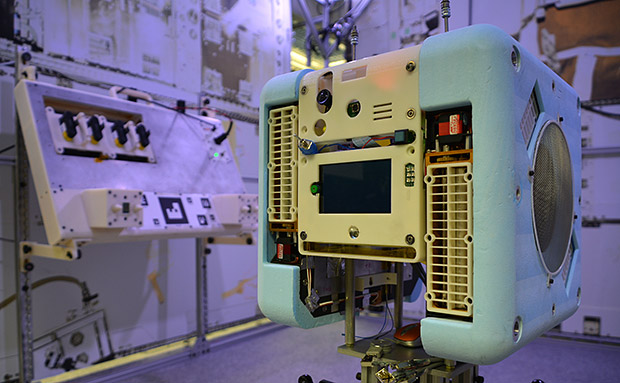These are the Astrobees, currently there are three of them, named Honey, Queen and Bumble.
这些是“宇航蜂”机器人,目前有三个,分别叫作“蜂蜜”“女王”和“大黄蜂”。
Two of them recently arrived in space and will soon be a part of the crew of the International Space Station.
其中两个是近期抵达太空的,并即将成为国际空间站一员。
So we have two robots Honey and Bumble are now on orbit and just last week we had our first checkout activity
目前,“蜂蜜”和“女王”正在轨道上,而就在上周我们进行了首次检查,
where Ann Mclean, one of the astronauts on orbit, unpacked and turned on and checked out Bumble, so Bumble is alive and well.
我们在轨道上的一名航天员,安·麦克莱恩打开包装,启动“大黄蜂”并进行检查,证明“大黄蜂”完好。
They are taking over from the Spheres, which were an earlier form of robot helpers on the ISS.
它们将代替“Spheres”机器人,它此前在国际空间站帮忙。
The Astrobees have cameras and microphones on board and during the next few months
“宇航蜂”机器人拥有摄像机和麦克风,那么在接下来的几个月里,
project manager Maria Bualat says they will be learning their way around the ISS.
项目经理玛利亚·布拉特说它们将开始熟悉空间站。

We are going to calibrate the cameras on board and do a mapping activity
我们将校准摄像机,并进行绘图,
where the astronaut will manually fly the robot back and forth across the Japanese experiment model to collect imagery data,
宇航员将手动让机器人在日本实验舱中来回飞翔,从而收集图像数据,
which we will use to build a map of the JEM, the Japanese experiment module.
从而用来制作日本实验舱地图。
Once they have an internal map the Astrobees will be able to find their way around the ISS on their own and begin doing some heavy lifting.
一旦拥有了内部地图,“宇航蜂”将能够自己熟悉空间站情况,并开始干一些重活。
We want to turn these into work horses. We want to free up astronaut time to let the crew do things that only humans can do.
我们希望让它们变成役马,从而节省宇航员时间,让他们干一些只有人类能做的事情。
And there is a saying in robotics in general, the three Ds, dirty, dangerous and dull,
在机器人学里有这么一句话,三个D,肮脏,危险和无聊,
right those are the things that you want a robot to do rather than have a human do.
我们希望让机器人做这些事情,而不是人类。
The Astrobee also has a lot of room for experiments, and middle and high schoolers around the country
“宇航蜂”还可以进行试验,全国的初高中学生
are already competing to get some of their experiments on board.
正竞争着让自己的试验进入“宇航蜂”。
The Astrobees docking module has already been installed and the tiny indoor satellites
“宇航蜂”对接舱已经建设完毕,小巧的室内卫星
will begin making their first voyages sometime in June.
将在6月份的某一时段进行首次旅程。
Kevin Enochs, VOA news
凯文·恩尼克斯,VOA新闻












